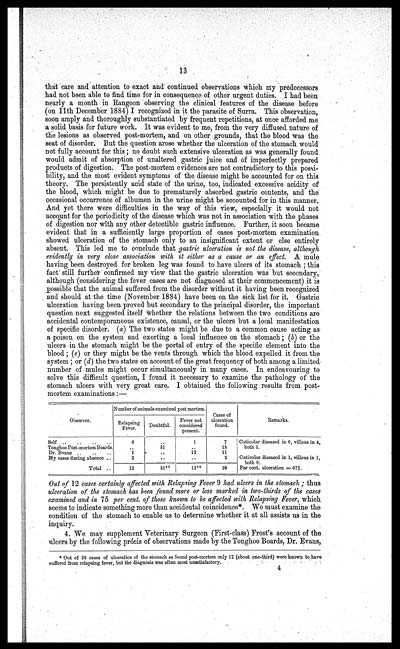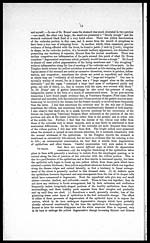Medicine - Veterinary > Veterinary diseases > Report of veterinary surgeon J.H. Steel, A.V.D., on his investigation into an obscure and fatal disease among transport mules in British Burma > Part II - Outbreaks
(26) Page 13
Download files
Individual page:
Thumbnail gallery: Grid view | List view

13
that care and attention to exact and continued observations which my predecessors
had not been able to find time for in consequence of other urgent duties. I had been
nearly a month in Rangoon observing the clinical features of the disease before
(on 11th December 1884) I recognized in it the parasite of Surra. This observation,
soon amply and thoroughly substantiated by frequent repetitions, at once afforded me
a solid basis for future work. It was evident to me, from the very diffused nature of
the lesions as observed post-mortem, and on other grounds, that the blood was the
seat of disorder. But the question arose whether the ulceration of the stomach would
not fully account for this ; no doubt such extensive ulceration as was generally found
would admit of absorption of unaltered gastric juice and of imperfectly prepared
products of digestion. The post-mortem evidences are not contradictory to this possi-
bility, and the most evident symptoms of the disease might be accounted for on this
theory. The persistently acid state of the urine, too, indicated excessive acidity of
the blood, which might be due to prematurely absorbed gastric contents, and the
occasional occurrence of albumen in the urine might be accounted for in this manner.
And yet there were difficulties in the way of this view, especially it would not
account for the periodicity of the disease which was not in association with the phases
of digestion nor with any other detectible gastric influence. Further. it soon became
evident that in a sufficiently large proportion of cases post-mortem examination
showed ulceration of the stomach only to an insignificant extent or else entirely
absent. This led me to conclude that gastric ulceration is not the disease, although
evidently in very close association with it either as a cause or an effect. A mule
having been destroyed for broken leg was found to have ulcers of its stomach ; this
fact still further confirmed my view that the gastric ulceration was but secondary,
although (considering the fever cases are not diagnosed at their commencement) it is
possible that the animal suffered from the disorder without it having been recognized
and should at the time (November 1884) have been on the sick list for it. Gastric
ulceration having been proved but secondary to the principal disorder, the important
question next suggested itself whether the relations between the two conditions are
accidental contemporaneous existence, causal, or the ulcers but a local manifestation
of specific disorder. (a) The two states might be due to a common cause acting as
a poison on the system and exerting a local influence on the stomach ; (b) or the
ulcers in the stomach might be the portal of entry of the specific element into the
blood ; (c) or they might be the vents through which the blood expelled it from the
system ; or (d) the two states on account of the great frequency of both among a limited
number of mules might occur simultaneously in many cases. In endeavouring to
solve this difficult question, I found it necessary to examine the pathology of the
stomach ulcers with very great care. I obtained the following results from post-
mortem examinations :—
|
Observer. |
Number of animals examined postmortem. |
Cases of |
Remarks. |
||
|
Fever. |
Doubtful. |
Fever not |
|||
|
Self .. .. .. .. |
9 |
.. |
1 |
7 |
Cuticular diseased in 6, villous in 4, |
|
Tonghoo Post-mortem Boards. |
.. |
31 |
.. |
18 |
|
|
Dr. Evans |
1 |
.. |
12 |
11 |
Cuticular diseased in 1, villous in 1. |
|
My cases during absence .. |
2 |
.. |
.. |
2 |
|
|
Total .. |
12 |
3143 |
1356 |
38 |
Per cent. ulceration = 67 6/7. |
Out of 12 cases certainly affected with Relapsing Fever 9 had ulcers in the stomach ; thus
ulceration of the stomach has been found more or less marked in two-thirds of the cases
examined and in 75 per cent, of those known to be affected with Relapsing Fever, which
seems to indicate something more than accidental coincidence*. We must examine the
condition of the stomach to enable us to determine whether it at all assists us in the
inquiry.
4. We may supplement Veterinary Surgeon (First-class) Frost's account of the
ulcers by the following precis of observations made by the Tonghoo Boards, Dr. Evans,
* Out of 38 cases of ulceration of the stomach as found post-mortem only 12 (about one-third) were known to have
suffered from relapsing fever, but the diagnosis was often most unsatisfactory.
4
Set display mode to: Large image | Zoom image | Transcription
Images and transcriptions on this page, including medium image downloads, may be used under the Creative Commons Attribution 4.0 International Licence unless otherwise stated. ![]()
| Permanent URL | https://digital.nls.uk/75189571 |
|---|




